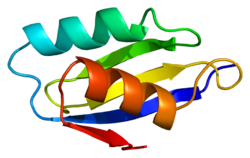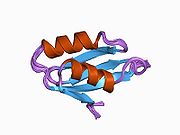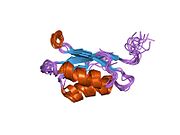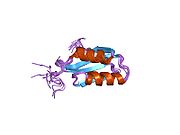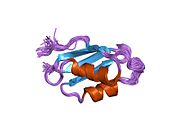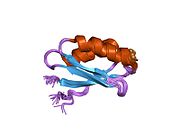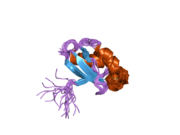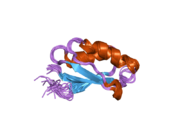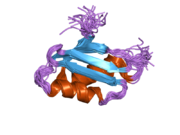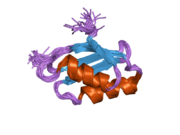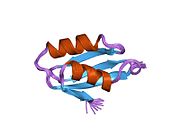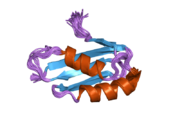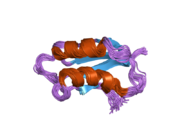- ATP7A
-
Copper-transporting ATPase 1 also known as copper pump 1 or Menkes disease-associated protein is a protein that in humans is encoded by the ATP7A gene.[1]
Contents
Gene
The ATP7A gene is located on the long (q) arm of the X chromosome between positions 13.2 and 13.3, from base pair 76,972,353 to base pair 77,112,036.
Function
ATP7A is important for regulating copper levels in the body. This protein is found in most tissues, but it is absent from the liver. In the small intestine, the ATP7A protein helps control the absorption of copper from food. In other organs and tissues, the ATP7A protein has a dual role and shuttles between two locations within the cell. The protein normally resides in a cell structure called the Golgi apparatus, which modifies and transports newly produced enzymes and other proteins. Here, the ATP7A protein supplies copper to certain enzymes that are critical for the structure and function of bone, skin, hair, blood vessels, and the nervous system. If copper levels in the cell environment are elevated, however, the ATP7A protein moves to the cell membrane and eliminates excess copper from the cell.
Interactions
ATP7A has been shown to interact with ATOX1[2] and GLRX.[3]
Clinical significance
Menkes syndrome is caused by mutations in the ATP7A gene. Researchers have identified more than 100 ATP7A mutations that cause Menkes syndrome and occipital horn syndrome, the milder form of Menkes syndrome. Many of these mutations delete part of the gene and are predicted to produce a shortened ATP7A protein that is unable to transport copper. Other mutations insert additional DNA building blocks (base pairs) or use the wrong building blocks, which leads to ATP7A proteins that do not function properly.
The altered proteins that result from ATP7A mutations impair the absorption of copper from food, fail to supply copper to certain enzymes, or get stuck in the cell membrane, unable to shuttle back and forth from the Golgi. As a result of the disrupted activity of the ATP7A protein, copper is poorly distributed to cells in the body. Copper accumulates in some tissues, such as the small intestine and kidneys, while the brain and other tissues have unusually low levels. The decreased supply of copper can reduce the activity of numerous copper-containing enzymes that are necessary for the structure and function of bone, skin, hair, blood vessels, and the nervous system.
References
- ^ Tümer Z, Møller LB, Horn N (1999). "Mutation spectrum of ATP7A, the gene defective in Menkes disease". Adv. Exp. Med. Biol. 448: 83–95. PMID 10079817.
- ^ Larin D, Mekios C, Das K, Ross B, Yang AS, Gilliam TC (October 1999). "Characterization of the interaction between the Wilson and Menkes disease proteins and the cytoplasmic copper chaperone, HAH1p". J. Biol. Chem. 274 (40): 28497–504. doi:10.1074/jbc.274.40.28497. PMID 10497213.
- ^ Lim CM, Cater MA, Mercer JF, La Fontaine S (September 2006). "Copper-dependent interaction of glutaredoxin with the N termini of the copper-ATPases (ATP7A and ATP7B) defective in Menkes and Wilson diseases". Biochem. Biophys. Res. Commun. 348 (2): 428–36. doi:10.1016/j.bbrc.2006.07.067. PMID 16884690.
Further reading
- Barnes N, Tsivkovskii R, Tsivkovskaia N, Lutsenko S (2005). "The copper-transporting ATPases, menkes and wilson disease proteins, have distinct roles in adult and developing cerebellum". J Biol Chem 280 (10): 9640–5. doi:10.1074/jbc.M413840200. PMID 15634671.
- Greenough M, Pase L, Voskoboinik I, Petris MJ, O'Brien AW, Camakaris J (2004). "Signals regulating trafficking of Menkes (MNK; ATP7A) copper-translocating P-type ATPase in polarized MDCK cells". Am J Physiol Cell Physiol 287 (5): C1463–71. doi:10.1152/ajpcell.00179.2004. PMID 15269005.
- Moller LB, Tumer Z, Lund C, Petersen C, Cole T, Hanusch R, Seidel J, Jensen LR, Horn N (2000). "Similar splice-site mutations of the ATP7A gene lead to different phenotypes: classical Menkes disease or occipital horn syndrome". Am J Hum Genet 66 (4): 1211–20. doi:10.1086/302857. PMC 1288188. PMID 10739752. http://www.pubmedcentral.nih.gov/articlerender.fcgi?tool=pmcentrez&artid=1288188.
- Voskoboinik I, Camakaris J (2002). "Menkes copper-translocating P-type ATPase (ATP7A): biochemical and cell biology properties, and role in Menkes disease". J Bioenerg Biomembr 34 (5): 363–71. doi:10.1023/A:1021250003104. PMID 12539963.
- Harris ED, Reddy MC, Qian Y, et al. (1999). "Multiple forms of the Menkes Cu-ATPase.". Adv. Exp. Med. Biol. 448: 39–51. PMID 10079814.
- Cox DW, Moore SD (2003). "Copper transporting P-type ATPases and human disease.". J. Bioenerg. Biomembr. 34 (5): 333–8. doi:10.1023/A:1021293818125. PMID 12539960.
- Voskoboinik I, Camakaris J (2003). "Menkes copper-translocating P-type ATPase (ATP7A): biochemical and cell biology properties, and role in Menkes disease.". J. Bioenerg. Biomembr. 34 (5): 363–71. doi:10.1023/A:1021250003104. PMID 12539963.
- La Fontaine S, Mercer JF (2007). "Trafficking of the copper-ATPases, ATP7A and ATP7B: role in copper homeostasis.". Arch. Biochem. Biophys. 463 (2): 149–67. doi:10.1016/j.abb.2007.04.021. PMID 17531189.
- Lutsenko S, LeShane ES, Shinde U (2007). "Biochemical basis of regulation of human copper-transporting ATPases.". Arch. Biochem. Biophys. 463 (2): 134–48. doi:10.1016/j.abb.2007.04.013. PMC 2025638. PMID 17562324. http://www.pubmedcentral.nih.gov/articlerender.fcgi?tool=pmcentrez&artid=2025638.
- Dierick HA, Ambrosini L, Spencer J, et al. (1996). "Molecular structure of the Menkes disease gene (ATP7A).". Genomics 28 (3): 462–9. doi:10.1006/geno.1995.1175. PMID 7490081.
- Tümer Z, Vural B, Tønnesen T, et al. (1995). "Characterization of the exon structure of the Menkes disease gene using vectorette PCR.". Genomics 26 (3): 437–42. doi:10.1016/0888-7543(95)80160-N. PMID 7607665.
- Kaler SG, Gallo LK, Proud VK, et al. (1995). "Occipital horn syndrome and a mild Menkes phenotype associated with splice site mutations at the MNK locus.". Nat. Genet. 8 (2): 195–202. doi:10.1038/ng1094-195. PMID 7842019.
- Das S, Levinson B, Whitney S, et al. (1994). "Diverse mutations in patients with Menkes disease often lead to exon skipping.". Am. J. Hum. Genet. 55 (5): 883–9. PMC 1918324. PMID 7977350. http://www.pubmedcentral.nih.gov/articlerender.fcgi?tool=pmcentrez&artid=1918324.
- Chelly J, Tümer Z, Tønnesen T, et al. (1993). "Isolation of a candidate gene for Menkes disease that encodes a potential heavy metal binding protein.". Nat. Genet. 3 (1): 14–9. doi:10.1038/ng0193-14. PMID 8490646.
- Mercer JF, Livingston J, Hall B, et al. (1993). "Isolation of a partial candidate gene for Menkes disease by positional cloning.". Nat. Genet. 3 (1): 20–5. doi:10.1038/ng0193-20. PMID 8490647.
- Vulpe C, Levinson B, Whitney S, et al. (1993). "Isolation of a candidate gene for Menkes disease and evidence that it encodes a copper-transporting ATPase.". Nat. Genet. 3 (1): 7–13. doi:10.1038/ng0193-7. PMID 8490659.
- Levinson B, Conant R, Schnur R, et al. (1997). "A repeated element in the regulatory region of the MNK gene and its deletion in a patient with occipital horn syndrome.". Hum. Mol. Genet. 5 (11): 1737–42. doi:10.1093/hmg/5.11.1737. PMID 8923001.
- Yamaguchi Y, Heiny ME, Suzuki M, Gitlin JD (1997). "Biochemical characterization and intracellular localization of the Menkes disease protein.". Proc. Natl. Acad. Sci. U.S.A. 93 (24): 14030–5. doi:10.1073/pnas.93.24.14030. PMC 19489. PMID 8943055. http://www.pubmedcentral.nih.gov/articlerender.fcgi?tool=pmcentrez&artid=19489.
- Petris MJ, Mercer JF, Culvenor JG, et al. (1997). "Ligand-regulated transport of the Menkes copper P-type ATPase efflux pump from the Golgi apparatus to the plasma membrane: a novel mechanism of regulated trafficking.". EMBO J. 15 (22): 6084–95. PMC 452430. PMID 8947031. http://www.pubmedcentral.nih.gov/articlerender.fcgi?tool=pmcentrez&artid=452430.
- Tümer Z, Lund C, Tolshave J, et al. (1997). "Identification of point mutations in 41 unrelated patients affected with Menkes disease.". Am. J. Hum. Genet. 60 (1): 63–71. PMC 1712537. PMID 8981948. http://www.pubmedcentral.nih.gov/articlerender.fcgi?tool=pmcentrez&artid=1712537.
- Dierick HA, Adam AN, Escara-Wilke JF, Glover TW (1997). "Immunocytochemical localization of the Menkes copper transport protein (ATP7A) to the trans-Golgi network.". Hum. Mol. Genet. 6 (3): 409–16. doi:10.1093/hmg/6.3.409. PMID 9147644.
- Ronce N, Moizard MP, Robb L, et al. (1997). "A C2055T transition in exon 8 of the ATP7A gene is associated with exon skipping in an occipital horn syndrome family.". Am. J. Hum. Genet. 61 (1): 233–8. doi:10.1016/S0002-9297(07)64297-9. PMC 1715861. PMID 9246006. http://www.pubmedcentral.nih.gov/articlerender.fcgi?tool=pmcentrez&artid=1715861.
- Gitschier J, Moffat B, Reilly D, et al. (1998). "Solution structure of the fourth metal-binding domain from the Menkes copper-transporting ATPase.". Nat. Struct. Biol. 5 (1): 47–54. doi:10.1038/nsb0198-47. PMID 9437429.
External Links
- MeSH ATP7A+protein,+human
- GeneReviews/NCBI/NIH/UW entry on ATP7A-Related Copper Transport Disorders Includes: Menkes Disease, Occipital Horn Syndrome, ATP7A-Related Distal Motor Neuropathy
- OMIM entries on ATP7A-Related Copper Transport Disorders
- GeneCard
PDB gallery 1aw0: FOURTH METAL-BINDING DOMAIN OF THE MENKES COPPER-TRANSPORTING ATPASE, NMR, 20 STRUCTURES1kvi: Solution Structure of the Reduced Form of the First Heavy Metal Binding Motif of the Menkes Protein1kvj: Solution Structure of the Cu(I) bound form of the first heavy metal binding motif of the Menkes protein1q8l: Second Metal Binding Domain of the Menkes ATPase1s6o: Solution structure and backbone dynamics of the apo-form of the second metal-binding domain of the Menkes protein ATP7A1s6u: Solution structure and backbone dynamics of the Cu(I) form of the second metal-binding domain of the Menkes protein ATP7A1y3j: Solution structure of the copper(I) form of the fifth domain of Menkes protein1y3k: Solution structure of the apo form of the fifth domain of Menkes protein1yjr: Solution structure of the apo form of the sixth soluble domain A69P mutant of Menkes protein1yjt: Solution structure of the Cu(I) form of the sixth soluble domain A69P mutant of Menkes protein1yju: Solution structure of the apo form of the sixth soluble domain of Menkes protein1yjv: Solution structure of the Cu(I) form of the sixth soluble domain of Menkes protein2aw0: FOURTH METAL-BINDING DOMAIN OF THE MENKES COPPER-TRANSPORTING ATPASE, NMR, 20 STRUCTURES2g9o: Solution structure of the apo form of the third metal-binding domain of ATP7A protein (Menkes Disease protein)2ga7: Solution structure of the copper(I) form of the third metal-binding domain of ATP7A protein (menkes disease protein)Hydrolases: acid anhydride hydrolases (EC 3.6) 3.6.1 3.6.2 3.6.3-4: ATPase 3.6.3Cu++ (3.6.3.4)Menkes/ATP7A · Wilson/ATP7BCa+ (3.6.3.8)Na+/K+ (3.6.3.9)H+/K+ (3.6.3.10)ATP4AOther P-type ATPase3.6.43.6.5: GTPase 3.6.5.1: Heterotrimeric G protein3.6.5.2: Small GTPase > Ras superfamily3.6.5.3: Protein-synthesizing GTPase3.6.5.5-6: Polymerization motorsB enzm: 1.1/2/3/4/5/6/7/8/10/11/13/14/15-18, 2.1/2/3/4/5/6/7/8, 2.7.10, 2.7.11-12, 3.1/2/3/4/5/6/7, 3.1.3.48, 3.4.21/22/23/24, 4.1/2/3/4/5/6, 5.1/2/3/4/99, 6.1-3/4/5-6 F- and V-type ATPase (3.A.2) P-type ATPase (3.A.3) - 3.A.3.1.1: Na+/K+ transporting: ATP1A1, ATP1A2, ATP1A3, ATP1A4, ATP1B1, ATP1B2, ATP1B3, ATP1B4, ATP1G1
- 3.A.3.1.2: H+/K+, H+/K+ exchanging: ATP4A, ATP4B
- 3.A.3.1.4: H+/K+ transporting, nongastric: ATP12A
- 3.A.3.2: Ca+ (SERCA, PMCA, SPCA) / Ca++ transporting: ATP2A1, ATP2A2, ATP2A3, ATP2B1, ATP2B2, ATP2B3, ATP2B4, ATP2C1
- 3.A.3.5: Cu++ transporting: ATP7A, ATP7B
- 3.A.3.8.8: flippase: ATP8A2
Other/ungrouped:
see also ATPase disorders
B memb: cead, trns (1A, 1C, 1F, 2A, 3A1, 3A2-3, 3D), othrMetabolism: Metal metabolism Transition metal OtherZinc metabolismElectrolyte Sodium metabolismPhosphate metabolismMagnesium metabolismM: NUT
cof, enz, met
noco, nuvi, sysi/epon, met
drug(A8/11/12)
Categories:- Human proteins
- Genes
Wikimedia Foundation. 2010.

